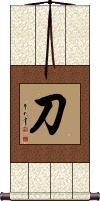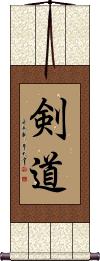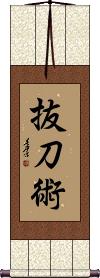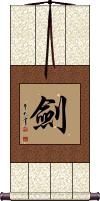Many custom options...
And formats...

Katana in Chinese / Japanese...
Buy a Katana calligraphy wall scroll here!
Personalize your custom “Katana” project by clicking the button next to your favorite “Katana” title below...
Katana
Japanese Samurai Sword
刀 is the Japanese Kanji for “sword.” This refers to the style of sword carried by warriors, samurai, and shogun of ancient Japan.
With the pacification of Japan, such swords are now only used for ceremony and decoration. The true art of sword-smithing is all but lost in Japan with new sword production dedicated to making inexpensive replicas for the tourist and foreign market.
For those of you that want to ask whether I can get you a real antique sword. Let me tell you that most real Asian swords were melted down after WWII in Japan, and during the Great Leap Forward in China. Any remaining swords are family heirlooms that nobody will part with.
Please carefully note that the Japanese kanji character shown above is only for a Japanese audience. In China, this character means “knife.” See our other entry for “sword” in Chinese.
Note: 刀 can mean knife, sword, or blade in Korean, depending on context.
See Also: Sword
Sword
剱 is the modern Japanese way to write sword.
This Kanji character comes from original Chinese. This form would also be understood in Chinese (there are often several ways to write the same character) but I suggest this one only if your audience is Japanese (because they've settled on a slightly different form as the standard in China).
In Japanese, this character also means saber/sabre, blade, bayonet, stinger, and clock hand (clock hands are the “swords” of the clock).
Kendo / The Way of the Sword
Often associated with Kenjutsu, 剱道/劍道 means “The way of the sword” in Japanese (and Korean with an alternate form of the first character).
This is also the term used for swordsmanship and even fencing in Japanese and Korean, depending on context.
Note: These same characters are also used separately in Chinese, but this exact combination yields a common title in Japanese only (perhaps someone who is really into swords would use this in China).
Note: There is more than one way to write the “sword” character (shown above is the Japanese version - if you want the Korean version, please let me know when you place your order).
See Also: Sword
Battojutsu
Sword
劍 is pronounced “jian” in Chinese. When you say it, imagine that you are making the sound of a sword as it clashes with a metal shield. This might get you closer to the correct pronunciation in Chinese.
I actually wonder if this word came from the metallic ringing sounds of a sword in battle - but such knowledge is lost in history.
The sword is a symbol of a warrior. The one thing that a soldier in ancient China lived and died by. A warrior with his skills and sword proves himself of great value. A warrior who losses his sword instantly becomes worthless.
劍 is an excellent scroll for someone in the military (especially officers of all services - as well as enlisted NCO Marines since they still carry swords even if mainly for ceremonial purposes). Or perhaps someone who practices variations of kung fu or tai chi that involve weapons.
Please note that while this character is understood with the sword meaning in Japanese, you might be looking for the word “katana” which also means sword in Japanese but means “knife” in Chinese.
There are other ways to write sword, and here are a few...
























![]()
![]()
![]()
![]()


If you are particular about the version you receive, please let me know when you place your order (Note: Special styles are only available from one of our master calligraphers).
Not the results for katana that you were looking for?
Below are some entries from our dictionary that may match your katana search...
| Characters If shown, 2nd row is Simp. Chinese |
Pronunciation Romanization |
Simple Dictionary Definition |
刀 see styles |
dāo dao1 tao katana(p); tou / katana(p); to かたな(P); とう |
More info & calligraphy: Katana(1) sword (esp. Japanese single-edged); katana; (2) (とう only) scalpel; (3) (とう only) (See 彫刻刀・ちょうこくとう) chisel; burin; graver; (4) (とう only) (See 刀銭) knife money (knife-shaped commodity money used in ancient China); (personal name) Tou sword |
両腰 see styles |
ryougoshi / ryogoshi りょうごし |
katana and wakizashi |
打刀 see styles |
uchigatana うちがたな |
(See 刀・1) katana; var. of Japanese long sword |
片名 see styles |
piān míng pian1 ming2 p`ien ming pien ming katana かたな |
movie title (place-name) Katana |
竹光 see styles |
takemitsu たけみつ |
(1) bamboo sword (resembling a katana, etc.); bamboo imitation sword; (2) dull sword; (surname) Takemitsu |
諸腰 see styles |
morokoshi; morogoshi もろこし; もろごし |
(rare) (See 両腰) katana and wakizashi |
佳多奈 see styles |
katana かたな |
(female given name) Katana |
日本刀 see styles |
rì běn dāo ri4 ben3 dao1 jih pen tao nihontou(p); nippontou / nihonto(p); nipponto にほんとう(P); にっぽんとう |
Japanese sword; katana Japanese sword (usu. single-edged and curved); Japanese bladed weapon |
武士刀 see styles |
wǔ shì dāo wu3 shi4 dao1 wu shih tao |
katana |
抜き打ち see styles |
nukiuchi ぬきうち |
(1) drawing a katana and attacking in the same stroke; (2) doing something suddenly, without warning |
上毛野形名 see styles |
kamitsukenukatana かみつけぬかたな |
(person) Kamitsukenu Katana |
Variations: |
uchigatana うちがたな |
(See 刀・1) katana (sword worn on the hip edge up by samurai) |
Variations: |
nukiuchi ぬきうち |
(1) drawing a katana and attacking in the same stroke; (noun - becomes adjective with の) (2) doing (something) suddenly and without warning; doing without prior notice |
Variations: |
tachi たち |
(1) long sword (as opposed to the shorter katana); (2) (太刀 only) (hist) tachi; sabre-like sword worn on the hip with the blade facing down |
The following table may be helpful for those studying Chinese or Japanese...
| Title | Characters | Romaji (Romanized Japanese) | Various forms of Romanized Chinese | |
| Katana | 刀 | katana | dāo / dao1 / dao | tao |
| Sword | 剱 剣 | ken | jiàn / jian4 / jian | chien |
| Kendo The Way of the Sword | 剱道 / 劍道 剣道 | kendou / kendo | jiàn dào / jian4 dao4 / jian dao / jiandao | chien tao / chientao |
| Battojutsu | 抜刀術 | battou jutsu battoujutsu batto jutsu | ||
| Sword | 劍 剑 | ken / tsurugi | jiàn / jian4 / jian | chien |
| In some entries above you will see that characters have different versions above and below a line. In these cases, the characters above the line are Traditional Chinese, while the ones below are Simplified Chinese. | ||||
Successful Chinese Character and Japanese Kanji calligraphy searches within the last few hours...








